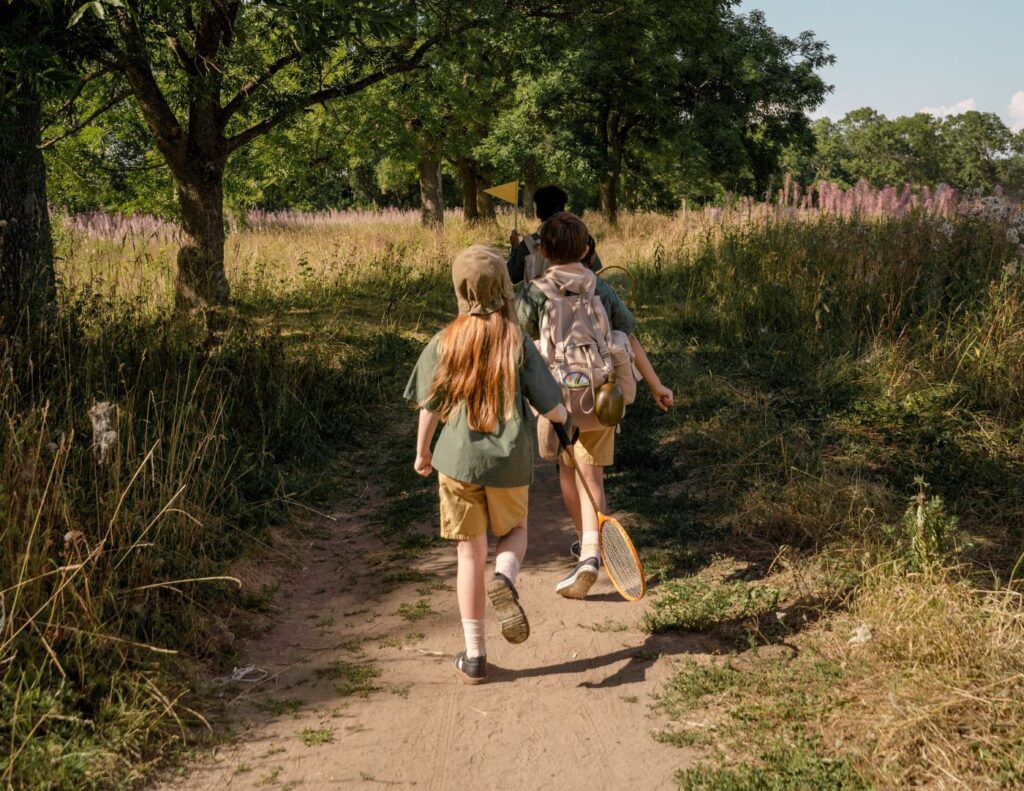Growing up in the foothills of the Adirondacks, I took natural beauty and the peace that comes along with it for granted. It didn’t really occur to me that most people’s childhoods did not look like mine. While my family certainly took the time for hikes, camping, and other experiences in nature, we hardly needed to; even a trip to the nearest bookshop or toy store involved nearly an hour’s drive through the wilderness.
For some earlier generations of Americans, it was a truism that time spent in nature was worthwhile for its own sake, and many have even argued that it has moral benefits. One of the most important ways that we have historically instilled the love of nature is through the institution of the summer camp. For anywhere from a few days to three months, adolescent campers spend their days hiking, boating, singing, crafting, and socializing in picturesque camps like those that dot the Adirondacks. Urban and suburban families in particular have prioritized sending their children to camps in order to give them a respite from their often hectic lives. Many Christian organizations, too, have historically dedicated funds to sponsoring young people’s time in these Edenic retreats, because they believe that these experiences can help young people grow into flourishing men and women.
Since the COVID-19 pandemic, though, overnight summer camps that emphasize time in nature are struggling to keep their enrollment up, and some now have significantly reduced programming or have closed completely. But this problem predates the pandemic, and it even predates the “demographic cliff” facing colleges and universities. In many young people’s lives, summer camps have slowly but surely been supplanted by academic and professionally oriented summer programs. Why has this been happening? And perhaps more importantly, what is being lost?
One of the most important ways that we have historically instilled the love of nature is through the institution of the summer camp.
Start your day with Public Discourse
Sign up and get our daily essays sent straight to your inbox.The Legacy of Summer Camp
While people have contended with the wilderness since European settlers first arrived in North America, it took until the mid-nineteenth century for camping to become a widely recognized pastime in the United States. Americans like William “Adirondack” Murray and Horace Kephart helped popularize camping. Murray’s 1869 book Adventures in the Wilderness; or, Camp-Life in the Adirondacks was particularly influential, helping inspire the modern conservation movement, the construction of over 200 grandiose camping grounds in the Adirondacks, and thousands of lifelong campers (at the time called “Murray’s fools” by some). While early American camping in the untamed wilderness was more limited to adults, Murray’s followers were part of a shift that helped initiate more children into the practice.
Englishmen like Thomas Hughes and Charles Kingsley had as much of a role in this change as Americans did. Hughes and Kingsley helped popularize a movement known as “muscular Christianity,” which reached its height with the election of Theodore Roosevelt as president of the United States. Adherents believed that much of modern Christianity misapplied St. Paul’s chastisement of the body. While the flesh can certainly lead man to sin, the body is a gift from God that can be used to glorify Him. They went further, arguing that an unhealthy neglect of one’s body is, if not itself sinful, certainly a cause of temptation.
Muscular Christians argued that modernity, with its bustling cities and loud machines, was preventing young people from cultivating healthy relationships with God, and that it had physically softened young people, especially young men. They were thus becoming not just physically weaker, but also less resilient and more liable to moral corruption. The muscular Christians’ antidote to this weakening was to push young men to nature, where they could cultivate physical strength through exercise, sports, and other outdoor activities.
Many organizations would propound and incarnate the ideals of muscular Christianity, the Young Men’s Christian Association, or YMCA, being the best known. Founded in England in 1844, the YMCA soon spread to the United States, where two of its representatives founded what would eventually become Camp Dudley, the first residential camp in the United States. Operating since 1885, Camp Dudley has served as an Adirondack refuge for boys from all backgrounds.
Camp Dudley was and is the quintessential American summer camp. The young men in attendance play every imaginable sport, from soccer and basketball to ultimate frisbee and lacrosse. They hike and sail, rock climb and play sports. They take part in activities like arts-and-crafts and theatrical performances. And, despite some bowing the knee on LGBT issues, the camp has retained something of its Christian character, inviting a speaker every Sunday morning and holding camp-wide hymn-singing every Sunday evening.
The young men at Camp Dudley are removed from the hustle-and-bustle that too often characterizes our lives. They exist in a place of natural beauty that encourages campers to enjoy themselves and befriend other boys. This space is also highly traditional, with days at camp looking much the same in 2023 as they would have in 1923. As historian Leslie Paris describes, “When campers sing old songs around the evening campfire or recycle camp conventions that have been in use since before their own grandparents were born, … two worlds—the historical and the present day—can overlap significantly.”
For decades, Camp Dudley was far from unique. There have been camps for Boy Scouts and camps for Girl Scouts, camps in the Rockies and camps in the Smokies, religiously affiliated camps and religiously neutral camps. I think, for instance, of Camp Guggenheim, a camp run by the Roman Catholic Diocese of Ogdensburg and located in Saranac Lake, where I spent many happy summers swimming, singing, and praying. Despite their seeming differences, the camps for young men and women dotting our nation’s forests have had something central in common: the promise of time and space for young people to experience the beauty of the natural world and grow physically, emotionally, and spiritually. Today, though, this traditional camp experience is becoming rarer and rarer.
Despite their seeming differences, the camps for young men and women dotting our nation’s forests have had something central in common: the promise of time and space for young people to experience the beauty of the natural world and grow physically, emotionally, and spiritually.
Achievement vs. Growth
This might sound like a strange claim. While increasing operational costs have sadly put summer camps out of reach for many Americans, parents of economically comfortable families still send their children to summer programs, indeed, to more than in the past. Everyone who knows parents of teens and tweens knows how common it is for children—especially middle- and upper-class children—to spend their summers hopping from camp to camp. But the “camps” many children attend are only a distant cousin of the kind of sylvan escapes imagined by the founders of Camp Dudley or Camp Guggenheim. Instead, they are essentially educational endeavors. There are music camps and theater camps, math camps and engineering camps, robotics camps and architecture camps.
Though participants certainly have fun at many of these camps, there is no denying that they are a fundamentally different experience from traditional sleepaway camps. They do not aim to provide experiences of friendship and physical exercise for their own sake within a beautiful natural backdrop. Instead, they are preparing participants to excel at something–often something that will prove professionally and economically beneficial to them.
Participants attend these programs, not simply for their own sake, but for the sake of accomplishment. To put it simply, these are camps that are meant to be chronicled in a college application, not a diary.
This touches on the crucial point: the traditional sleepaway camp and the contemporary educational camp work from different notions—or at least aspects—of human formation. The sleepaway camp hopes to form young men and women who, no matter their paths in life, will develop a lasting love for nature, physical competence, and a sense of adventure and authentic leisure. While campers are likely to cultivate various skills, they are focused on their enjoyment of the activities and the beauty of the setting, not the skills themselves. The contemporary educational camp, however, aims to form each participant to excel in a single specialty.
The traditional sleepaway camp and the contemporary educational camp work from different notions—or at least aspects—of human formation. The sleepaway camp hopes to form young men and women who, no matter their paths in life, will develop a lasting love for nature, physical competence, and a sense of adventure and authentic leisure.
There is, of course, nothing wrong with cultivating skills through this kind of program. The various excellences that these camps hope to encourage are, for the most part, worth achieving, and it is thus a good thing to be formed to cultivate them. But there is something lost when young people only attend summer programs that are pushing them to achieve something. Summer once served as a respite from the school year’s pressure to perform, but for many adolescents, it has become simply an extension of this pressure. This is terribly shortsighted. As a 2005 article in the Archives of Pediatrics & Adolescent Medicine put it, “Children will be smarter, better able to get along with others, healthier and happier when they have regular opportunities for free and unstructured play in the out-of-doors.”
From obvious scourges like drug and alcohol use to more insidious issues like pornography addiction, feelings of hopelessness, and social isolation, young people are not faring well. Perhaps most harrowingly, according to the National Alliance on Mental Illness, a staggering 20 percent of high school students report serious thoughts of suicide and between one and two percent of people aged 18–25 have attempted suicide in the last year.
There is no single smoking gun that causes all these problems. People can persuasively argue—and have argued—for the damaging effects of everything from fatherless homes and addictive smartphones to the COVID-19 lockdowns and rhetoric around climate change. But the pressure to perform is unequivocally a part of this story. Many young people feel as though they must be productive at all costs. Many are desperate to achieve entrance into impossibly competitive elite universities, as Jay Caspian Kang has recently detailed in the New Yorker. The traditional summer camp, with its life-affirming emphasis on enjoying nature, community, and athletic activity for their own sake, stands in stark contrast to this increasingly damaging mindset.
Parents who encourage their children to attend achievement-oriented summer programs only want the best for their kids. Households with two working parents and no strong support network are put in a difficult spot each year when summer rolls around. Quality childcare is expensive and increasingly difficult to find, and parents often struggle with guilt over “sending their children away” during the summer. As long as they will be spending money on some kind of childcare, then, it is natural for parents to want their children to have an enriching experience. In recent years, though, parents themselves have come to be put under a similar kind of pressure: trying to secure spaces at programs that are affordable, prestigious, and competitive. As Elliot Haspel put it, “Full-time working parents face a Hunger Games landscape of limited, expensive slots.”
Scientific findings have consistently told us what philosophy and religion have taught all along: the human person needs silence and peace in order to develop a healthy interior life. The intellectual life and the spiritual life both require interior quiet, but the pressures our hyper-meritocratic systems place on young people have made it harder and harder to cultivate. While traditional summer camps are bursting with activities, their natural settings and daily rhythms have a meditative quality to them, encouraging campers to become more present with themselves and their surroundings. They are a welcome respite from the competitiveness and workism that permeate our culture, even the youngest among us.
Widespread revitalization of the traditional summer camp would require action from many quarters: policymakers would need to work to lessen burdensome restrictions on camps, philanthropists and religious organizations would need to redouble financial support of traditional camps, and competitive colleges would need to change their admissions expectations. But this revitalization begins with individual parents encouraging their children to attend summer camp, whether with their own money or through the financial aid that many camps still provide for students in need.
To put it simply, the original rationale for summer camp is more valid than ever. Young people are struggling with mental health, addiction to technology, disconnection from the body, isolation, and many other painful realities. Summer camps cannot fix these problems. But for many adolescents, the experience of traditional summer camps might help them see that life is about more than accomplishment, and that is a start.
The featured image is by cottonbro studio and is in the public domain courtesy of pexels.com.
Important announcement: Introducing our new Ethics Advice Column! This week, submit your ethical questions to Chris Tollefsen, our expert in natural law philosophy and ethics. Each quarter, we will publish Chris’s responses to select questions.













